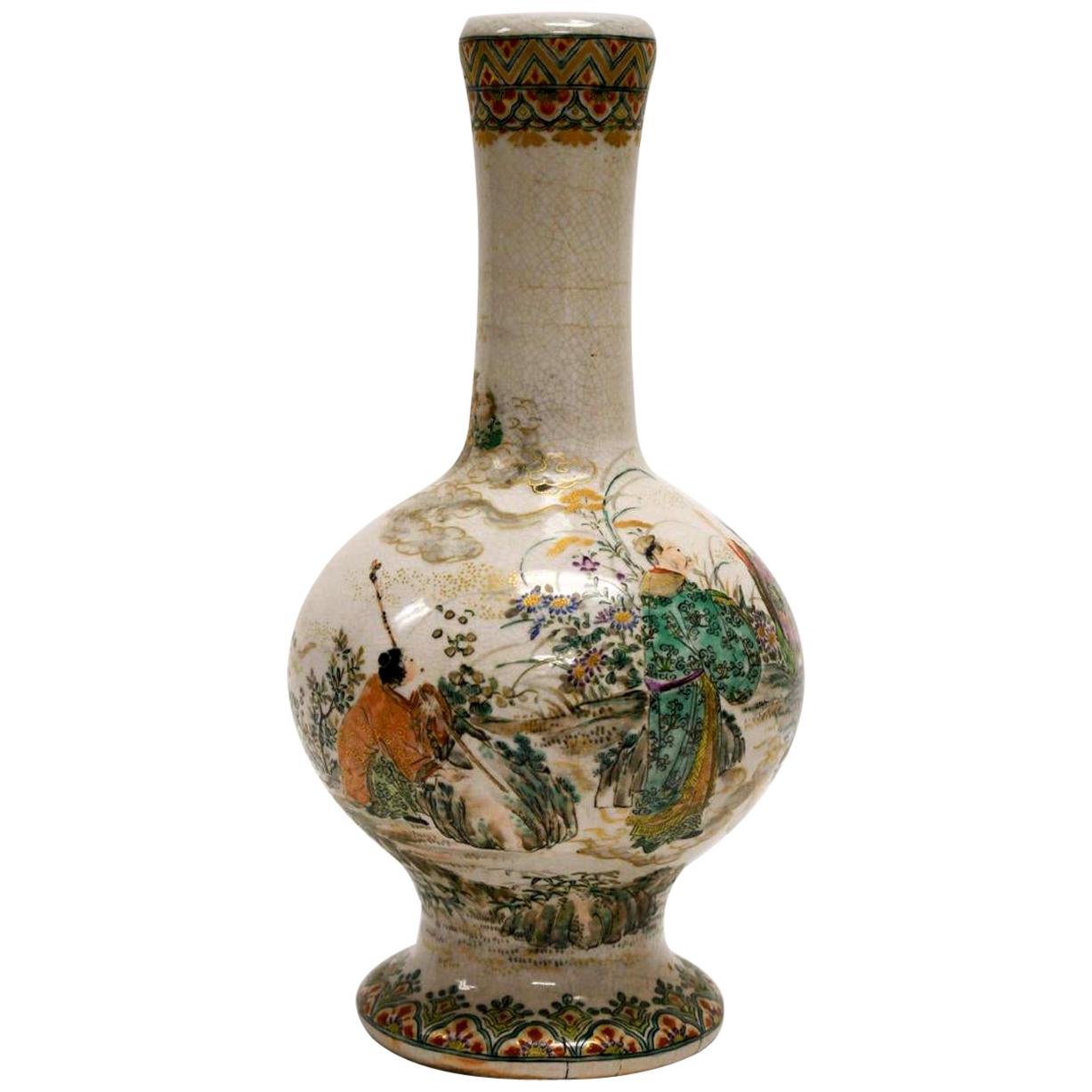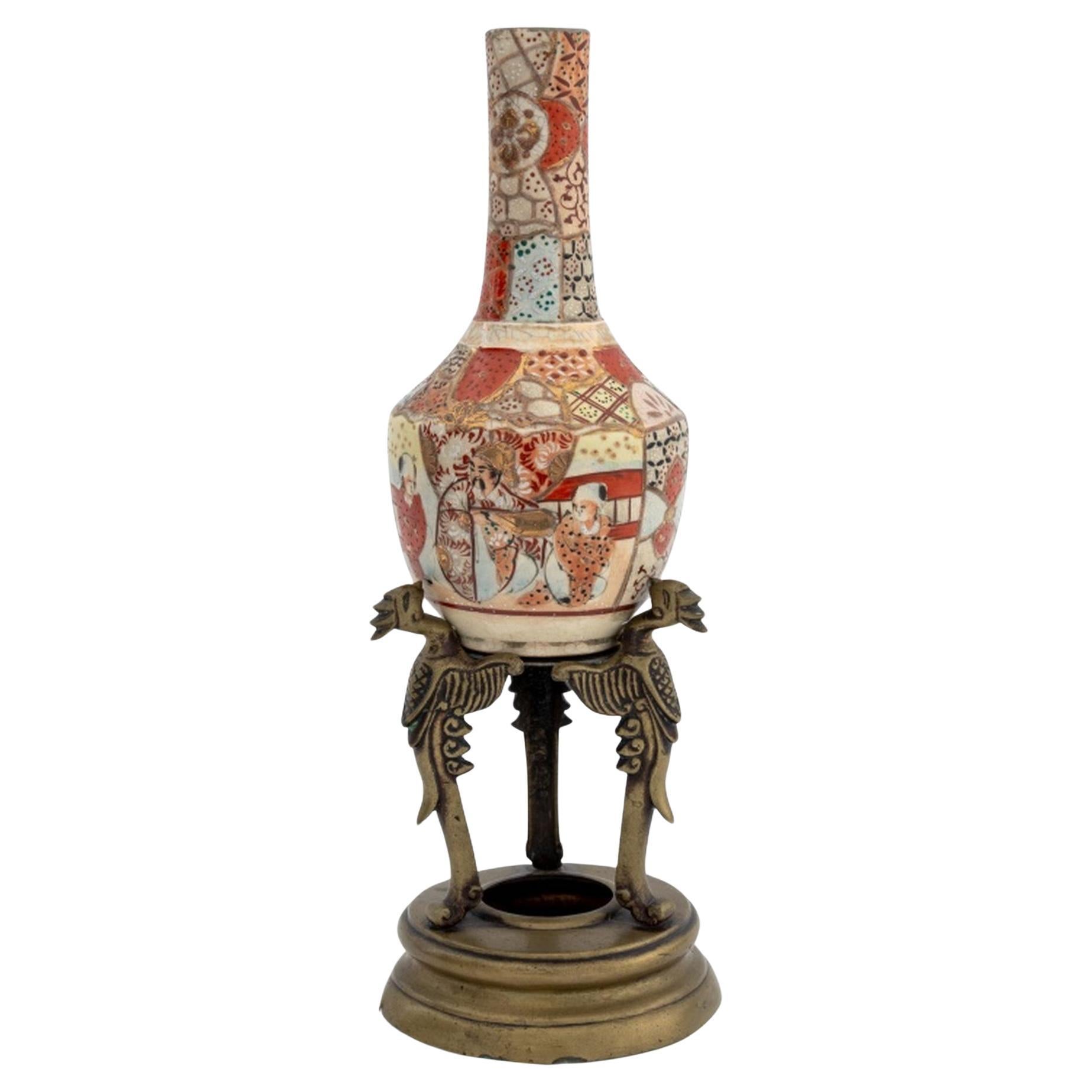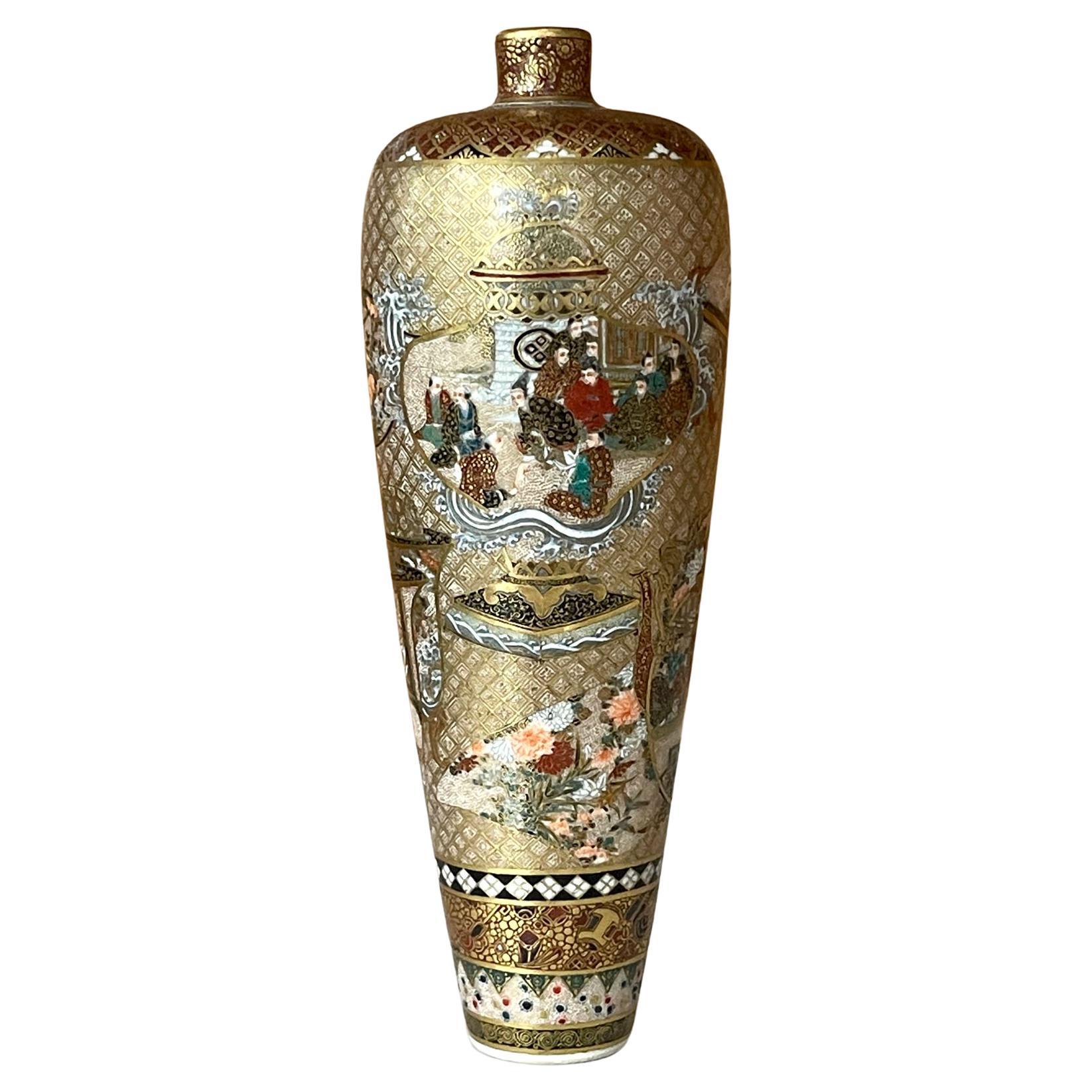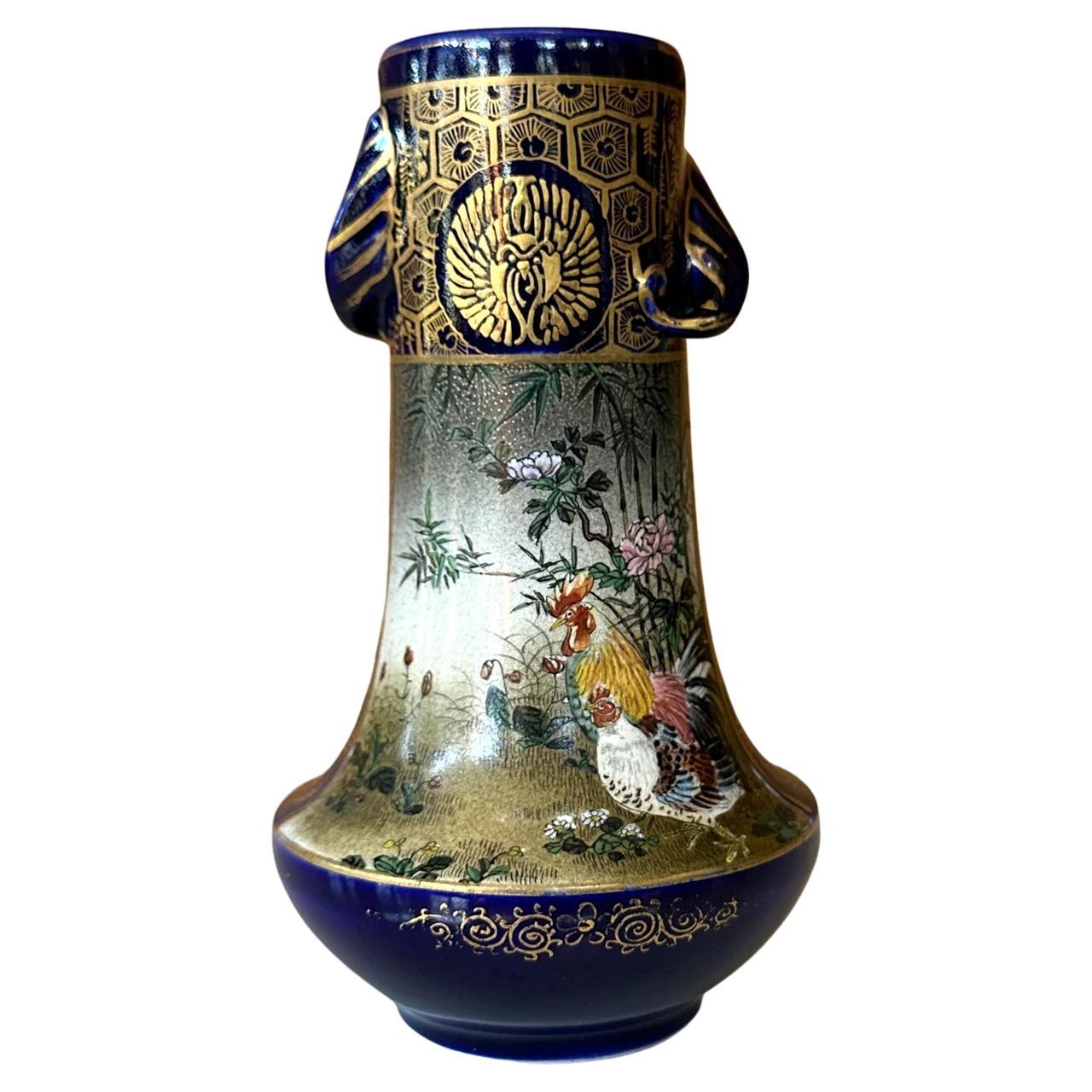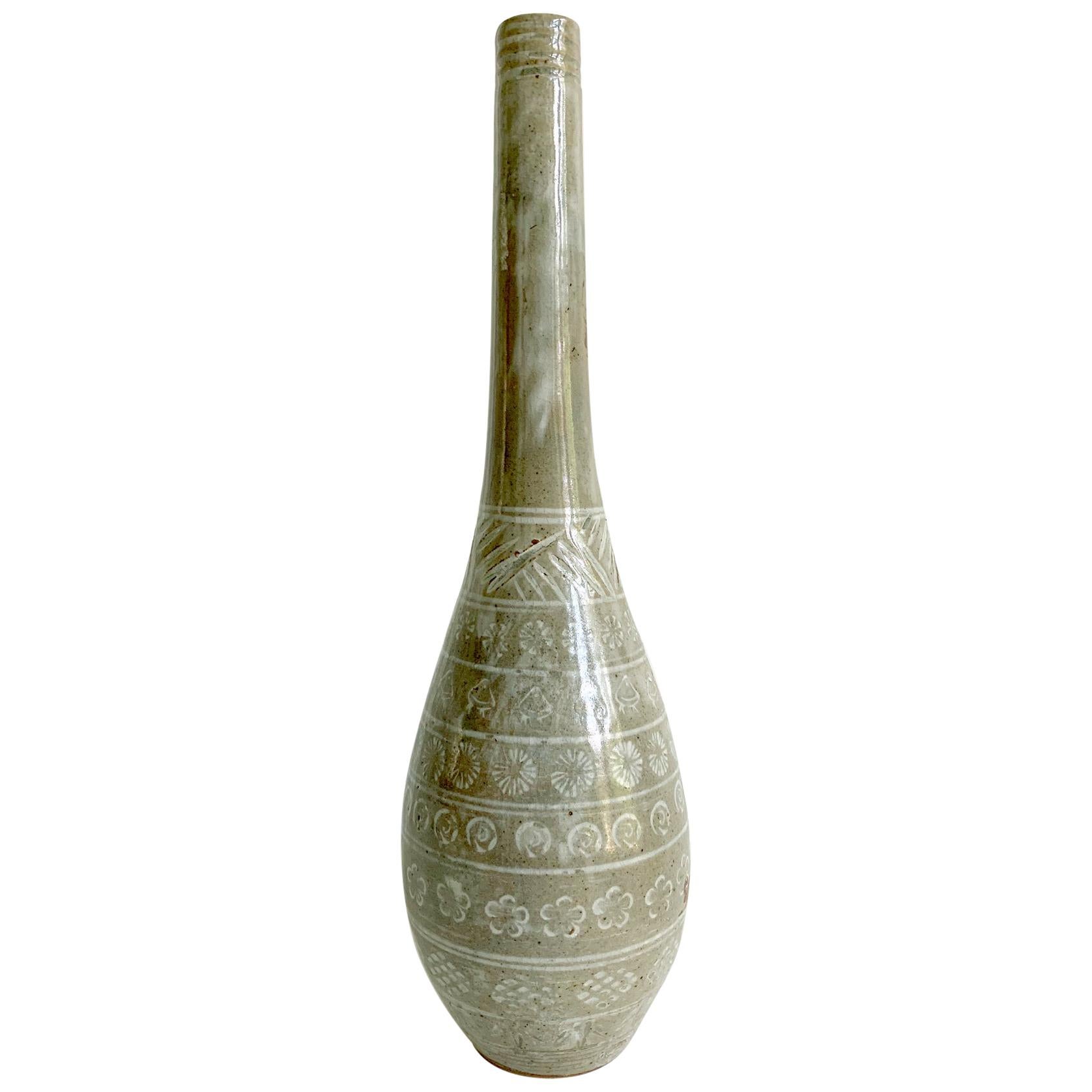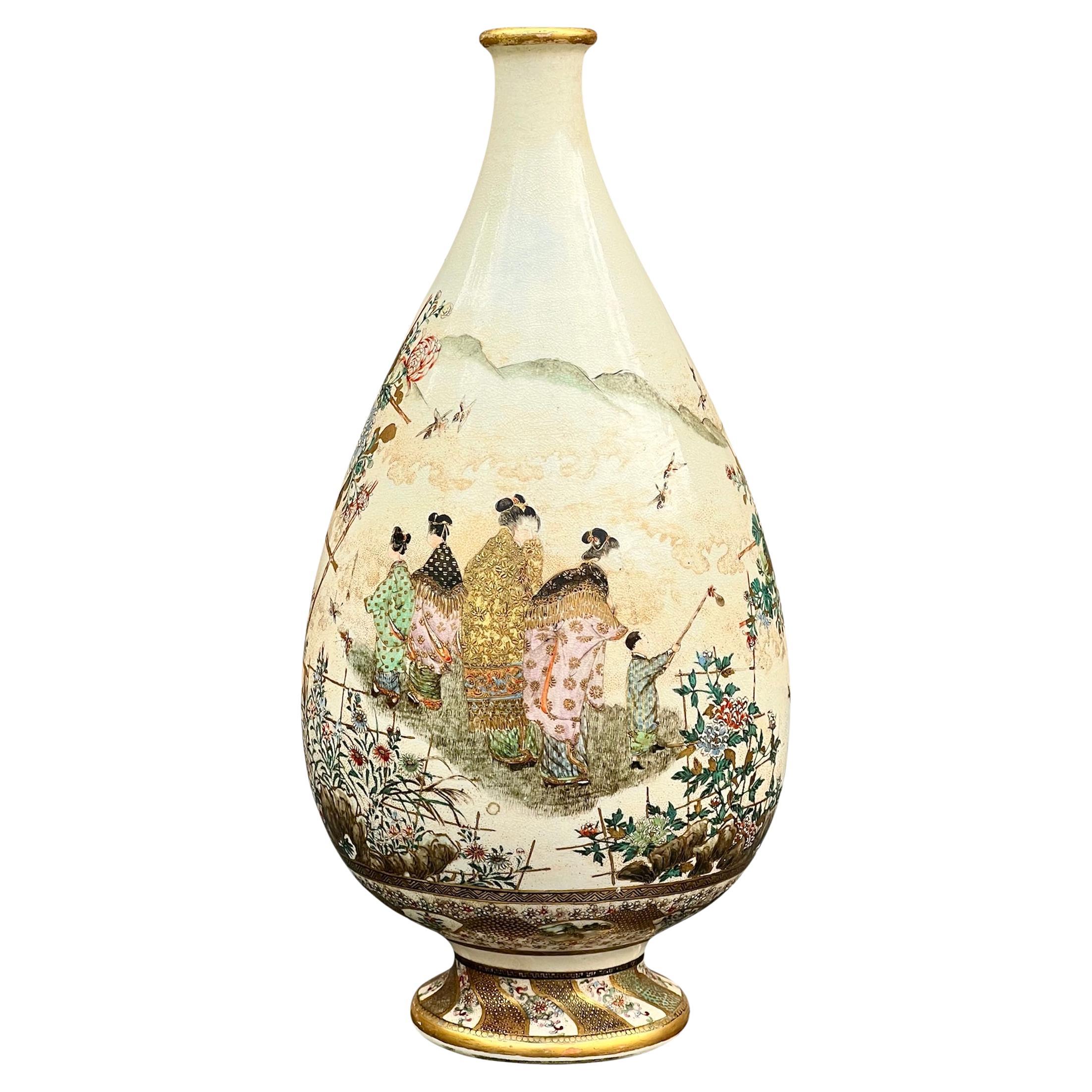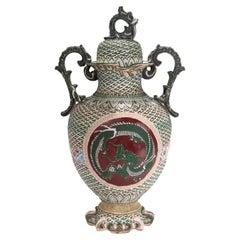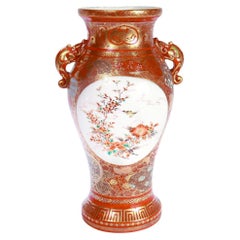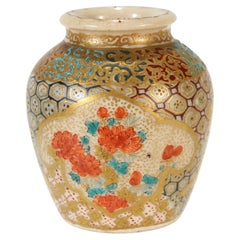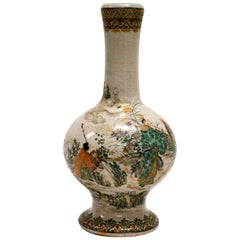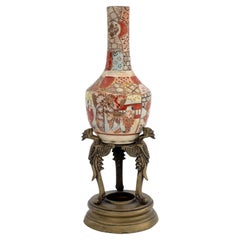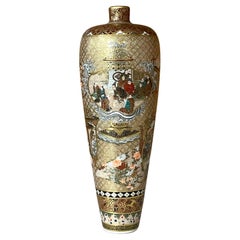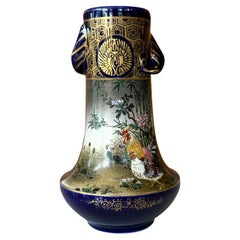Items Similar to Antique Japanese Satsuma Pottery Bud Vase
Want more images or videos?
Request additional images or videos from the seller
1 of 14
Antique Japanese Satsuma Pottery Bud Vase
$595
£451.47
€516.22
CA$831.05
A$924.02
CHF 482.47
MX$11,247.56
NOK 6,156.13
SEK 5,768
DKK 3,852.63
Shipping
Retrieving quote...The 1stDibs Promise:
Authenticity Guarantee,
Money-Back Guarantee,
24-Hour Cancellation
About the Item
A fine antique Japanese Satsuma pottery vase.
In the form of a bud vase with a round base and narrow, tapered neck.
Decorated throughout with gilding & enamel complete with extensive embossed textures and patterns.
There are three cartouches to the body of the vase. Two of the cartouches depict finely clad noblemen sitting outside, and the third cartouche depicts of a pair of sparrows sitting on the branches of a cherry blossom tree.
Simply a wonderful Japanese bud vase!
Date:
Late 19th or Early 20th Century
Overall Condition:
It is in overall good, as-pictured, used estate condition with no chips, cracks, or repairs.
Condition Details:
There is fine and tight crazing throughout. Otherwise, there are some fine & light surface scratches and other signs of expected light wear consistent with age.
Marks:
Unmarked
Measurements:
Height: ca. 5 1/4 in.
Diameter: ca. 3 in.
Items purchased from this dealer must delight you. Purchases may be returned for any reason for a period of 7 days.
- Similar to:Makuzu Kozan (Maker)
- Dimensions:Height: 5.25 in (13.34 cm)Diameter: 3 in (7.62 cm)
- Style:Meiji (In the Style Of)
- Materials and Techniques:
- Place of Origin:
- Period:
- Date of Manufacture:Late 19th or Early 20th Century
- Condition:Wear consistent with age and use. There is fine and tight crazing throughout. Otherwise, there are some fine & light surface scratches and other signs of expected light wear consistent with age.
- Seller Location:Philadelphia, PA
- Reference Number:Seller: 9112023193318DSAINVCHJY231stDibs: LU1610236323442
About the Seller
5.0
Gold Seller
Premium sellers maintaining a 4.3+ rating and 24-hour response times
Established in 1996
1stDibs seller since 2015
536 sales on 1stDibs
Typical response time: 1 hour
- ShippingRetrieving quote...Shipping from: Philadelphia, PA
- Return Policy
Authenticity Guarantee
In the unlikely event there’s an issue with an item’s authenticity, contact us within 1 year for a full refund. DetailsMoney-Back Guarantee
If your item is not as described, is damaged in transit, or does not arrive, contact us within 7 days for a full refund. Details24-Hour Cancellation
You have a 24-hour grace period in which to reconsider your purchase, with no questions asked.Vetted Professional Sellers
Our world-class sellers must adhere to strict standards for service and quality, maintaining the integrity of our listings.Price-Match Guarantee
If you find that a seller listed the same item for a lower price elsewhere, we’ll match it.Trusted Global Delivery
Our best-in-class carrier network provides specialized shipping options worldwide, including custom delivery.More From This Seller
View AllAntique Japanese Moriage Nippon Porcelain Vase or Covered Jar
Located in Philadelphia, PA
A fine antique Japanese Nippon porcelain vase or covered urn.
With green, pink, and white tones in raised moriage enamel that gives a three-dimensional effect.
Decorated with 4 cartouches throughout. The main cartouche features a moriage dragon...
Category
20th Century Japanese Meiji Ceramics
Materials
Enamel
Antique Japanese Meiji Period Kutani Porcelain Vase by Shoundo / Matsumoto Sahei
Located in Philadelphia, PA
A fine antique Japanese Meiji period Kutani porcelain vase.
By Matsumoto Sahei/Shoundo.
In an aka-e style decorated throughout in iron red with extensive gilt accents.
There are cartouches to either side both with branches of red flower with a backdrop of clouds on a white ground.
With 2 figural dragon finial handles.
Marked to the base with '九谷松雲堂製' which translates as 'Made by Shoundo of Kutani'
Matsumoto Sahei (1851-1918) was a master potter who enjoyed success & recognition during his era. In 1876, Sahei received the artist name Shoundo from the nanga painter Tokuda Kansho - he would use that title for nearly 20 years until passing it onto his son as his successor in 1893. Sahei also has the distinction of taking Tokuda Yasokichi I as an apprentice when the latter was 17-years-old. The Tokuda family is perhaps one of the most famous families of Japanese ceramics: Yasokichi I is credited with revitalizing the lost art of ko-Kutani and Yasokichi I, II, & III were all recognized as "Living National Treasures" during their lifetimes.
Shoundo exhibited internationally numerous times at the tail end of the 19th Century. The Keisei Isogaya Museum of Art (which specializes in Meiji Kutani) has a vase of Sahei's that was exhibited in the Philadelphia Centennial Exhibition of 1876. He is listed as exhibiting a wide variety of porcelain goods at the 1878, 1889, and 1900 Paris World Exhibitions. He is also listed as exhibiting 'incense burners & porcelain' at the World's Columbian Exhibition held in 1893 in Chicago. The pair of vases that Sahei exhibited in Paris in 1900 bear a strong resemblance to this pair.
Simply a wonderfully rare Japanese porcelain...
Category
Early 20th Century Japanese Meiji Ceramics
Materials
Porcelain
Antique Japanese Satsuma Miniature Cabinet Vase
By Master Ryozan
Located in Philadelphia, PA
A fine diminutive, antique Japanese Satsuma pottery cabinet vase.
Decorated throughout with gilding and raised enamel.
There are...
Category
20th Century Japanese Meiji Vases
Materials
Ceramic
Antique Signed Japanese Meiji Period Mixed Metals Bronze Double Gourd Form Vase
Located in Philadelphia, PA
A fine antique Japanese bronze vase.
From the Meiji Period.
With copper and silver floral and vine and butterfly inlay as well a kanji symbol to the neck (possibly a stylized f...
Category
Early 20th Century Japanese Meiji Vases
Materials
Silver, Bronze, Copper
Antique Chinese Export Porcelain Bud Vase or Miniature Cabinet Vase
Located in Philadelphia, PA
A fine Chinese export porcelain bud vase or miniature cabinet vase.
With a white porcelain ground and a faceted six-sided body.
The long sides respectively have a painted old man a...
Category
Early 20th Century Chinese Chinese Export Ceramics
Materials
Porcelain
Antique Chinese Rose Mandarin Porcelain Vase, 19th Century
Located in Philadelphia, PA
A very fine, antique Chinese Rose Mandarin porcelain vase.
With rich polychrome enamel decoration on a light celadon ground.
An excel...
Category
Antique 19th Century Chinese Chinese Export Ceramics
Materials
Porcelain
You May Also Like
Early Japanese Satsuma Antique Vase
By Satsuma
Located in Atlanta, GA
An Satsuma ceramic stone ware vase, circa 19th century, around the end of the Edo and the beginning of Meiji period. In the form of a Classic garlic bottle whose prototype was from China, the white bodied piece is decorated with an early form of kin nishikide, the so called golden brocade, a palette of iron-red, blue, green, yellow, purple and black with golden highlight. The over glazed enamel paint shows a group of robed figures in a garden setting with a lion and three tigers. A transparent overall glaze shows very fine crackles. The design is relatively sparse with plenty of negative space in contrast to the Satsuma production from the late 19th century, when the trend became fussy and overly glitz, due to the influence by the perceived western taste for the export market. This piece may still be made for export but its pattern was more influenced by both Kyoto Pottery and the Kano school of painting compared to the export ware by the end of the 19th century onward to the early 20th century. It was believed by many that this was a result of Satsuma potters visiting Kyoto in the late seventeenth century to learn over glaze painting techniques.
There are some age glaze crackles especially around the foot. The piece is not signed in keeping with the earlier production before Satsuma ceramics...
Category
Antique Mid-19th Century Japanese Japonisme Ceramics
Materials
Ceramic
$2,850 Sale Price
25% Off
Japanese Satsuma Pottery Bottle Vase
Located in Astoria, NY
Japanese Satsuma Pottery Bottle Vase, with painted and gilt figural interior scenes mounted on brass griffin base. Overall: 12.25" H x 4.75" Diameter. Provenance: From the Collection...
Category
20th Century Japanese Meiji Ceramics
Materials
Brass
Exquisite Japanese Satsuma Vase by Seikozan
Located in Atlanta, GA
A miniature vase in elegant upright form reminiscent of the Chinese imperial Willow Leaf form made by Japanese studio Seikozan circa 1890-1910s (late Meiji Period). One of the many a...
Category
Antique 1880s Japanese Meiji Ceramics
Materials
Ceramic
Fine Japanese Ceramic Satsuma Vase by Kinkozan
By Kinkozan
Located in Atlanta, GA
A miniature Japanese ceramic vase from the end of Meiji period circa 1880s- 1910s by Kinkozan (1645-1927). One of the largest studio manufacturers of the export ceramics at the time ...
Category
Early 20th Century Japanese Meiji Ceramics
Materials
Ceramic
Japanese Mishima Ceramic Vase Meiji Period
Located in Atlanta, GA
A Japanese long neck slender ceramic vase in the style of Mishima, circa 19th century, Meiji period. Mishima pottery was originally imported from three islands in Taiwan and then fro...
Category
Antique 19th Century Japanese Japonisme Ceramics
Materials
Ceramic
A Fine Japanese Satsuma Vase . Meiji Period. Kinkozan
Located in London, GB
A Fine Japanese Satsuma Vase with Bijin, Peacock, and Chrysanthemums.
Attributed to Kinkozan Workshop, Kyoto, Meiji period (late 19th century)
Of pear-shaped form with a flared f...
Category
Antique 19th Century Japanese Ceramics
Materials
Ceramic, Porcelain
More Ways To Browse
Antique Japanese Pottery
Japanese Antique Marks
Japan Art Cherry
Cherry Blossom Trees
Signed Japanese Pottery
Japanese Cherry Tree
Light 5 Branches
Antique Bud Vase
Unmarked Pottery
Bud And Blossom
19th Century Japanese Satsuma Vases
Cherry Blossom Vase
Antique 19th Century Japanese Satsuma Vase Vases
Late Mayers Pottery
Satsuma Pottery
Japanese Satsuma Pottery
Meiji Pottery Vases
20th Century Satsuma Vase
